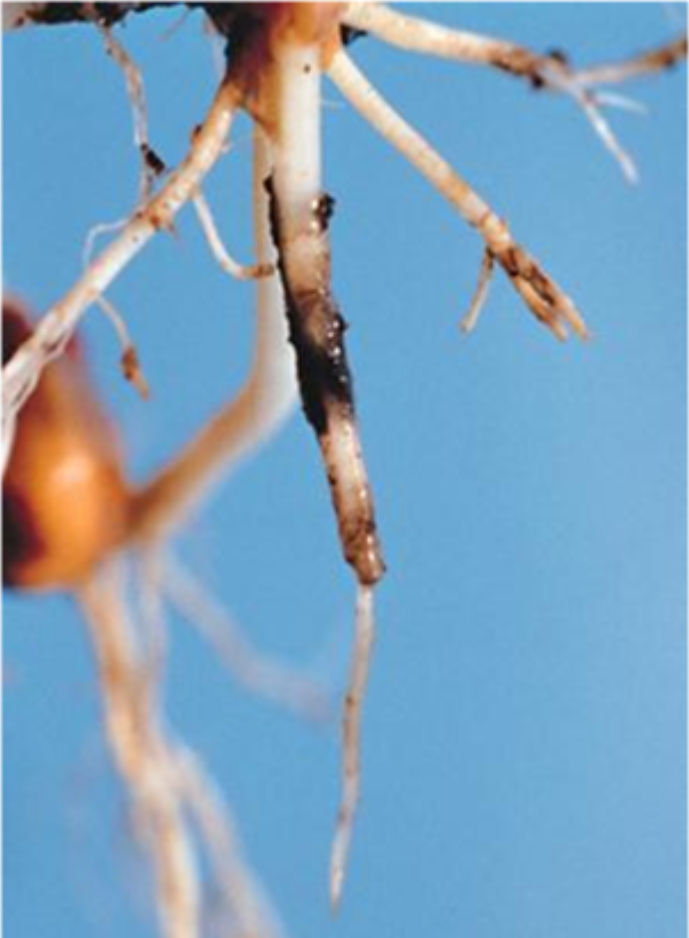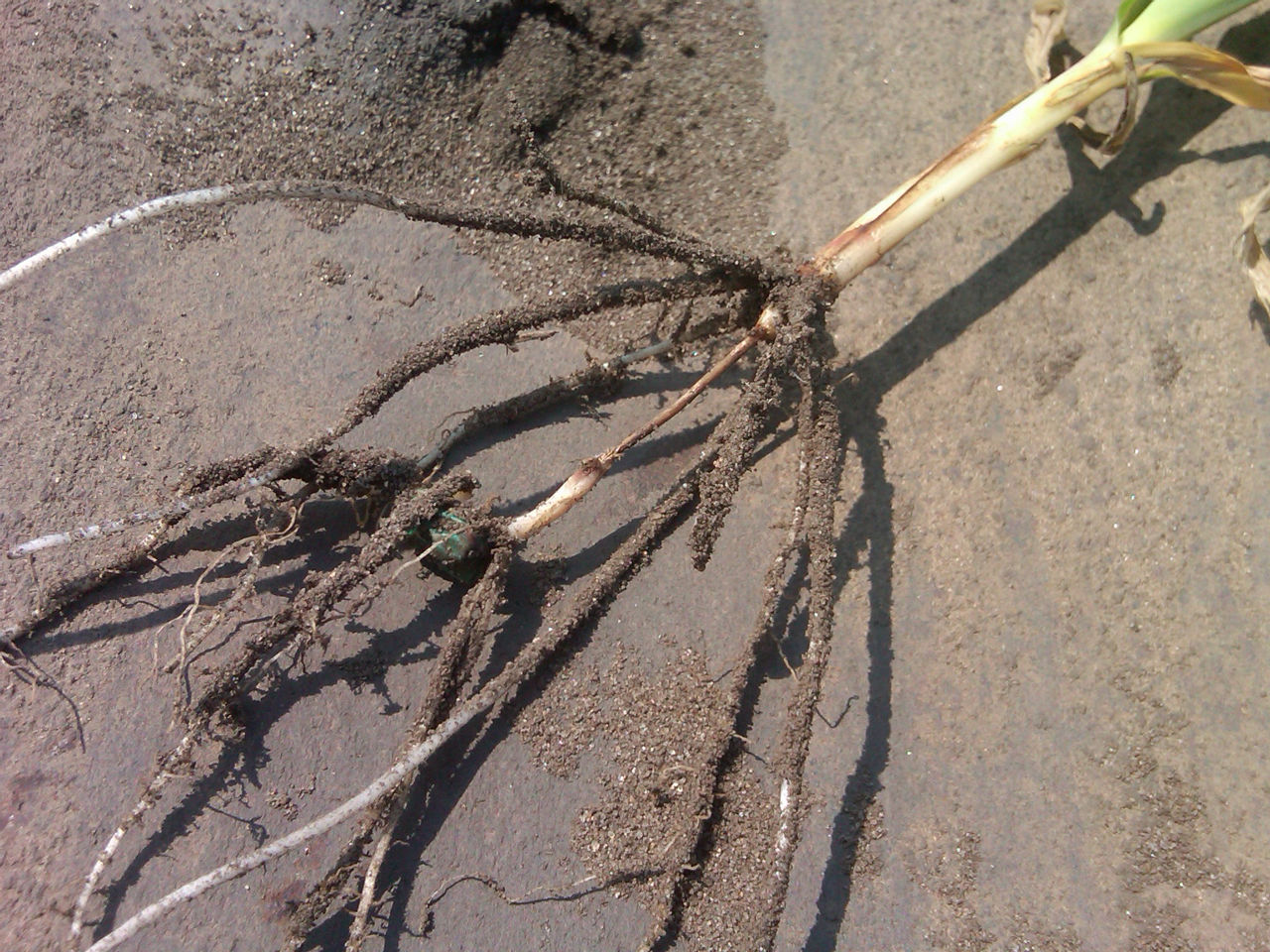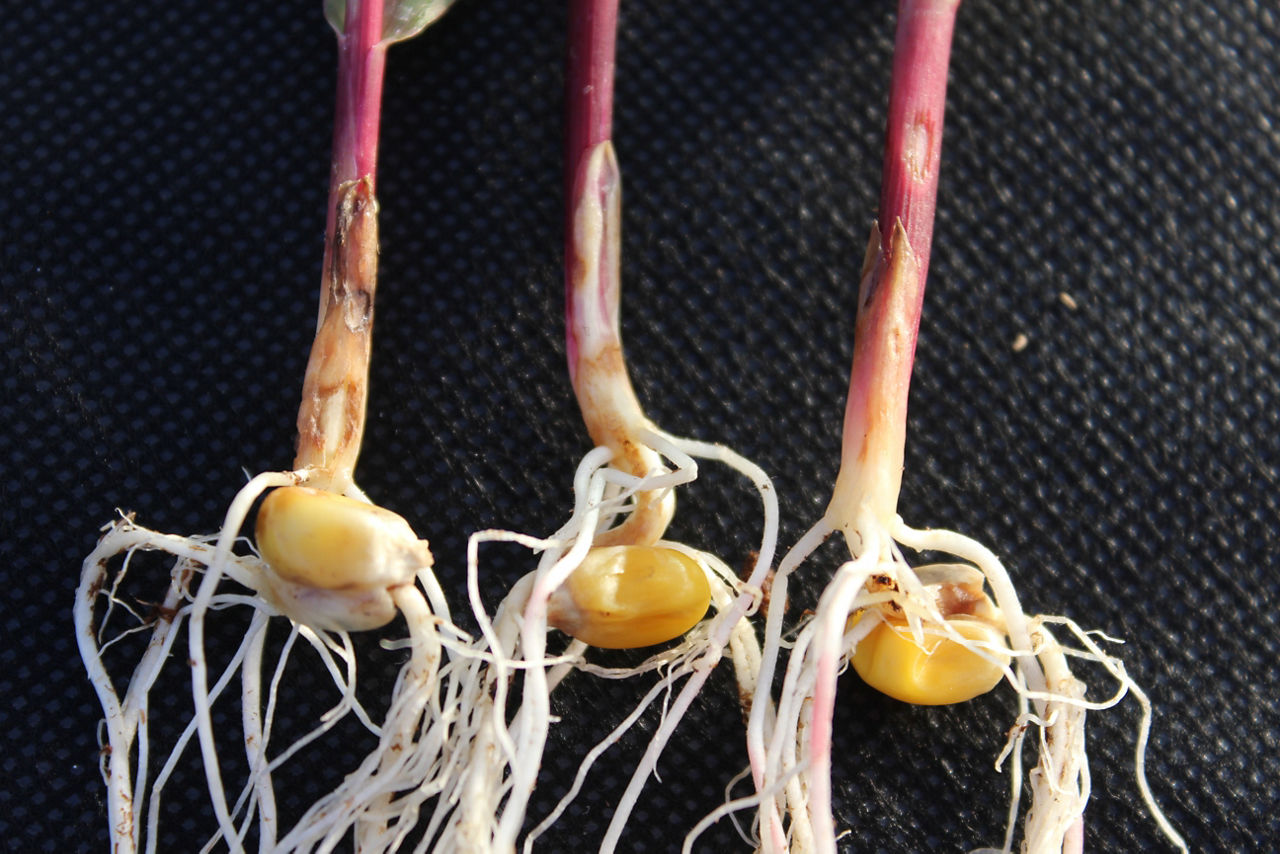7 MIN READ
Corn Seedling Disease Identification and Management
May 21, 2024
Introduction
Seedling diseases can be caused by many common soilborne organisms. Pythium, Fusarium, Rhizoctonia, and Penicillium are the most common fungal plant pathogens that cause seedling rots or damping off (post emergence seedling dieback). Stunting, discoloration, damping off, and root rot are common symptoms of corn seedling diseases. These fungi may overwinter on corn crop residue or in soil and are carried on seed. Not all damping off damage is caused by pathogens as there are many plant parasitic nematodes that can cause similar symptoms. Rotted seedlings can be the result of anhydrous ammonia injury, wireworm damage, and cold injury. Corn seeds that remain in cool soils without germinating are more stressed and susceptible to fungal infection. The stem of infected seedlings becomes brown and soft near the soil line. Aboveground symptoms include stunting, yellowing, wilting, and death of the leaves. Seedling diseases are often difficult to diagnose because their similarity of symptoms. The best way to positively identify the cause(s) of the problem is to send samples of the diseased plants to a plant diagnostic clinic that offers microscopic examination and other laboratory analyses of diseased seedlings. It is not uncommon to isolate multiple root-infecting fungi from one infected seedling and root sample. In addition, seedling diseases can be confused with insect injury, herbicide damage, planting problems, or growing condition stresses that often have similar symptoms.
Symptoms of seedling diseases include:
- Rotted seed prior to germination.
- Rotted or discolored seedlings after germination prior to emergence.
- Post-emergence seedling damping off.
- Root or hypocotyl (region between the seed and the permanent root system) decay.1
Root rots occur to some extent in every field and can cause economic loss under wet conditions. Seed rot is often severe in early-planted or no-till/reduced tillage fields because of cooler soil temperatures.
Causes of Seedling Diseases
Root rots are prevalent in poorly drained soils, excessively compacted or cold (less than 55 °F, 12 °C) and wet soils.2 Disease severity is affected by planting depth, soil type, age and quality of the seed, mechanical injury to the seed coat, insect feeding, and the level of genetic resistance to infection.
Pythium

Pythium symptoms include dark, slimy lesions that cause the root or mesocotyl to shrivel. The outer cortex of the root may rot while the inner part, or stele, remains white and intact. Pythium is one of the most common fungi associated with seed rot and seedling blight of corn. At least fourteen species of Pythium have been identified that can cause seed rot prior to germination or infect young seedlings before or after emergence. Pythium-associated problems are favored by cold, wet soils and are more problematic in the wettest areas of a field (low spots). The key factor for Pythium is excessive water – when soil is saturated for an extended period, regardless of the temperature, Pythium-associated damping off may occur. This fungus requires wet soil to produce infecting spores. Strains of Pythium that are more adapted to warmer, wet conditions have developed in some locations. Pythium can infect anytime between planting and midseason but is primarily a seedling problem.
Fusarium

Initial symptoms of Fusarium-infected corn seedlings are tan to reddish brown lesions on the root or mesocotyl and the mesocotyl may shrivel. Symptoms on larger roots range from very slight brown discoloration to dark black, completely rotted roots. At least eight Fusarium species have been identified that cause seedling diseases and root rots in corn.3 Fusarium has a wide range of favorable temperatures and moisture conditions and is common in corn plants that have been stressed by cold temperatures, compaction, and saturated soils. Plant susceptibility to root rot increases when plants are under stress or injured by herbicide applications. Root rots occurring after the seedling stage are often caused by Fusarium. Insect feeding injury to the roots or crown can cause Fusarium root rot to move into the base of the corn plant. Late Fusarium infections result in crown and stalk rot after pollination and during grain fill.
Rhizoctonia

Initial symptoms of Rhizoctonia-infected corn seedlings are brown lesions on the mesocotyl and roots of seedlings and young plants that can girdle and rot off roots. The most distinctive symptoms are reddish brown sunken cankers, which form on the roots, crown, and brace roots of larger plants. Rhizoctonia-infected plants may be stunted or chlorotic, but often there are no aboveground symptoms. Rhizoctonia species cause seedling diseases but tend to be more common in drier growing conditions and more severe in irrigated corn. Rhizoctonia can infect corn roots between 46 to 82 °F (8 to 28 °C) and can also cause crown rot and brace root rot on older plants. Older plants may lodge due to a poor root system.
Penicillium

The roots and mesocotyl of Penicillium-infected plants may be discolored and rotted. Sometimes a blue-green fungal growth can be seen on infected seeds. Symptoms of this seedling blight include browning of leaf tips. Entire infected plants may turn yellow and die or remain discolored and stunted for the remainder of the growing season. This fungus is favored by high temperatures, which can inhibit other fungi. Penicillium tends to infect plants prior to nodal root development.
Control of Seedling Rots of Corn
- Genetic Resistance
Genetic resistance is not available for seedling root rot or damping off diseases in corn. Crop rotation can provide some reduction in disease, but some pathogens may also infect soybean and other crops.
- Cultural Control
Use high quality seed and good cultural practices, such as planting seed in warm soil (above 55 °F, 12 °C), preparing seedbed properly, and optimum water management (do not over irrigate during germination or early plant development). Plant when soil conditions are warmer and drier and ensure planting depth is not too deep.
- Seed Treatments
Seed treatment fungicides containing metalaxyl, mefenoxam, or ethaboxam can help provide protection against Pythium. For Fusarium, several fungicide groups have activity including demethylation inhibitors (DMIs/FRAC 3), quinone outside inhibitors (strobilurins/FRAC 11), and succinate dehydrogenase inhibitors (SDHIs/FRAC 7).4 Acceleron® Seed Applied Solutions ELITE provides protection against soilborne and seedborne diseases, including Fusarium, Rhizoctonia solani, and Pythium with the fungicides metalaxyl, ethaboxam, prothioconazole, and fluoxastrobin at rates that can help control additional diseases. The effective residual from any of these fungicides is around two to three weeks (depending on soil conditions). Seed treatments may vary in effectiveness depending on the Pythium and Fusarium species present. Acceleron® Seed Applied Solutions ELITE also contains the insecticide clothianidin.
Sources
1Mueller, N. and Jackson-Ziems, T. 2016. Seedling diseases developing in corn. CROPWATCH. University of Nebraska-Lincoln. https://cropwatch.unl.edu/2016/seedling-diseases-developing-corn#:~:text=Figure%201.,the%20healthy%20plant%20(right).
2Davis, R.M. Seed rot and damping-off. 2008. UC IPM Pest Management Guidelines:Corn. UC ANR Publication 3443 University of California Agricultural and Natural Resources. http://ipm.ucanr.edu/PMG/r113100411.html#:~:text=SYMPTOMS%20AND%20SIGNS,soft%20near%20the%20soil%20line.
3Byamukama, E. and Mathew, F. 2022. Fusarium root and crown rot developing in corn. South Dakota State University Extension. https://extension.sdstate.edu/fusarium-root-and-crown-rot-developing-corn#:~:text=A%20corn%20stem%20split%20to%20reveal%20rotting.
4Friskop, A. 2019. Root rots, seedling blights, and seed decay of corn. Crop and Pest Report. North Dakota State University. https://www.ag.ndsu.edu/cpr/plant-pathology/root-rots-seedling-blights-and-seed-decay-of-corn-05-30-19.
Web sources verified 3/29/24 1211_119498.
You may also like...
Here are some articles that may also be of interest to you